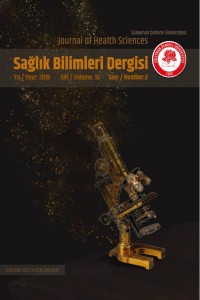Öz
Özet
Amaç: İnaktivite,
ergonomik olmayan çalışma koşulları ve emosyonel stres sonucunda sağlıklı
bireylerde görülen doğal eğriliklerde modifikasyonlar oluşmaktadır. Bu
modifikasyonlar çoğunlukla hatalı sırt postürü veya mobilitede yetersizlikle
sonuçlanabilir veya neden olabilmektedir. Bu çalışma sağlıklı genç bireylerde
torakal ve lumbal eğrilikleri ile gövde kaslarının güç ve enduransı arasındaki
ilişkisini incelenmesi amacıyla planlanmıştır.
Materyal-Method: Çalışmaya 18-25 yaş arası olan 113 sağlıklı
genç birey dahil edilmiştir. Gövde kaslarının gücü sit-up ve modifiye push-up
testleri ile değerlendirilmiştir. Gövde kaslarının enduransını değerlendirmek için lateral
köprü testi, Sorensen testi ve gövde fleksörleri endurans testi kullanılmıştır.
Torakal ve lumbal bölge eğriliklerinin değerlendirmek için Spinal Mouse cihazı kullanılmıştır.
Bulgular:
Torakal ve lumbal bölge eğrilikleri ile gövde kas gücü ve enduransı arasında
istatistiksel olarak anlamlı ilişki bulunmuştur (p˂0,05). Yapılan Linear
Regresyon Analiz sonucunda torakal eğrilikleri lateral köprü testinin (p˂0,05),
lumbal eğrilikleri ise sit-up ve gövde fleksörleri endurans testinin etkilediği
belirlenmiştir (p˂0,05).
Sonuç:
Bu çalışmada gövde kaslarının kas gücü ve enduransı ile torakal ve lumbal bölge
eğrilikleri arasında anlamlı bir ilişki bulmuştur. Sonuç olarak torakal ve
lumbal bölge eğriliklerinin sağlıklı genç bireylerde kapsamlı
değerlendirmelerin yapılması ve bu değerlendirmeler içinde özellikle gövde
kaslarının olması gerektiği düşünülmektedir.
Anahtar Kelimeler
Kaynakça
- 1. Yaman O, Dalbayrak S. Kifoz: tanı, gruplama ve tedavi yöntemleri. Türk Nöroşirürji Dergisi. 2013; 23(2): 61-73.
- 2. Tokar E, Karacaer Ö, Pehlivan N. Diş Hekimliğinde Ergonomi. Atatürk Üniversitesi, Diş Hekimliği Fakültesi Dergisi. 2014; 24(8): 117-124.
- 3. Lau KT, Cheung KY, Chan KB, Chan MH, Lo KY, Chiu TT. Relationships between sagittal postures of thoracic and cervical spine, presence of neck pain, neck pain severity and disability. Manual Therapy. 2010; 15(5): 457-62.
- 4. Ehrmann Feldman D, Shrier I, Rossignol M, Abenhaim L. Risk factors for the development of neck and upper limb pain in adolescents. Spine (PhilaPa 1976). 2002: 27(5): 523-8.
- 5. O’Sullivan PB, Mitchell T, Bulich P, Waller R, Holte J. The relationship between posture and back muscle endurance in industrial workers with flexion-related low back pain. Manual Therapy. 2006; 11(4): 264-71.
- 6. Tully EA, Fotoohabadi MR, Galea MP. Sagittal spine and lower limb movement during sit-to-stand in healthy young subjects. Gait Posture. 2005; 22(4): 338-45.
- 7. Kneafsey R, Haigh C. Learning safe patient handling skills: Student nurse experiences of university and practice based education. Nurse Education Today. 2007; 27(8): 832-39.
- 8. Sinaki M, Itoi E, Rogers JW, Bergstralh EJ, Wahner HW. Correlation of back extensor strength with thoracic kyphosis and lumbar lordosis in estrogen-deficient women. American Journal of Physical Medicine Rehabilitation. 1996; 75(5): 370–4.
- 9. O’Sullivan PB, Grahamslaw KM, Kendell M, Lapenskie SC, Moller NE, Richards KV. The effect of different standing and sitting postures on trunk muscle activity in a pain-free population. Spine (PhilaPa 1976). 2002; 27(11): 1238-44.
- 10. Hertling D, Kessler RM. Management of Common Musculoskeletal Disorders. In: Hertling D, editor. The Thoracic Spine. Philedelphia: Lippincott Williams & Wilkins, 1996. p. 570-621.
- 11. Falla, D. (2008). Neuromuscular control of the cervical spine in neck pain disorders. USA: Medical science. 14-16.
- 12. Vleeming, A, Poo-Goudzwaard, AL, Stoeckart R., van Wingerden JP, Snijders CJ.. The posterior layer of the thoracolumbar fascia. Its function in load transfer from spine to legs. Spine. 1995; 20(7): 753-758.
- 13. Kibler WB, Press J, Sciascia A. The role of core stability in athletic function. Sports Medicine. 2006; 36(3): 186-198.
- 14. Leetun DT, Ireland ML, Willson JD, Ballantyne BT, Davis IM. Core stability measures as risk factors for lower extremity ınjury in athletes. Medicine & Science in Sports & Exercise. 2004; 36(6): 926-934.
- 15. Ropponen A, Gibbons LE, Videman T, Battié MC. Isometric back extension endurance testing: reasons for test termination. The Journal of Orthopaedic and Sports Physical Therapy. 2005; 35(7): 437-42.
- 16. Moreland J, Finch E, Stratford P, Balsor B, Gill C. Interrater reliability of six tests of trunk muscle function and endurance. The Journal of Orthopaedic and Sports Physical Therapy. 1997; 26(4): 200-208.
- 17. Post RB, Leferink VJ. Spinal mobility: sagittal range of motion measured with the SpinalMouse, a new non-invasive device. Archieves Orthopaedic of Trauma Surgery. 2004; 124(3): 187-92.
- 18. Fon GT, Pitt MJ, Thies AC. Thoracic kyphosis: range in normal subjects. AJR American Journal of Roentgenology. 1980; 134(5): 979-83.
- 19. Mejia EA, Hennrikus WL, Schwend RM, Emans JB. A prospective evaluation of idiopathic left thoracic scoliosis with MRI. Journal of Pediatric Orthopedics. 1996; 16(3): 354-358.
- 20. Tüzün C, Yorulmaz I, Cindas A, Vatan S. Low back pain and posture. Clinical Rheumatology.1999; 18(4): 308-312.
- 21. Lord MJ, Small JM, Dinsay JM, Watkins RG. Lumbar lordosis: effects of sitting and standing. Spine, 1997; 22(21): 2571-4.
- 22. Walker ML, Rothstein JM. Finucane SD, Lamb RL. Relationship between lumbar lordosis, pelvic tilt, and abdominal muscle performance. Physical Therapy. 1987; 67(4): 512–516.
- 23. Youdas JW, Garrett TR, Harmsen S. Lumbar lordosis and pelvic inclination of asymptomatic adults. Physical Therapy. 1996; 76(10): 1066–1081.
- 24. Roussouly P, Nnadi C. Sagittal plane deformity: an overview of interpretation and management. European Spine Journal. 2010;19(11): 1824–36.
- 25. Kim MS, Chung SW, Hwang C, Ki LC, Soon CB. A radiographic analysis of sagittal spinal alignment for the standardization of standing lateral position. Journal of the Korean Orthopaedic Association. 2005; 40(7): 861–7.
Ayrıntılar
| Birincil Dil | Türkçe |
|---|---|
| Konular | Sağlık Kurumları Yönetimi |
| Bölüm | Araştırma Makaleleri |
| Yazarlar | |
| Yayımlanma Tarihi | 16 Haziran 2019 |
| Gönderilme Tarihi | 13 Aralık 2018 |
| Yayımlandığı Sayı | Yıl 2019 Cilt: 10 Sayı: 2 |


